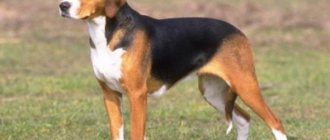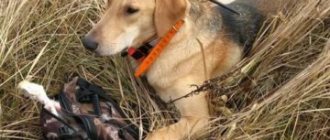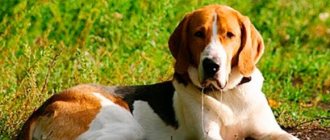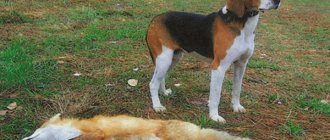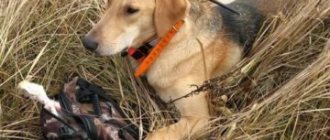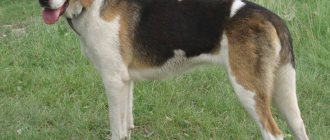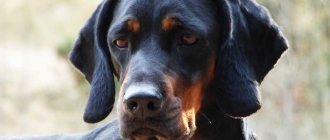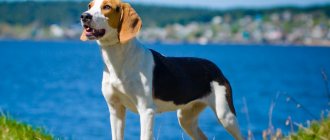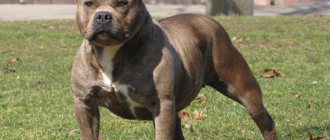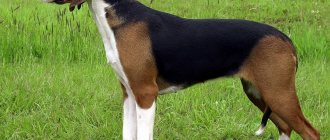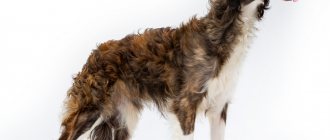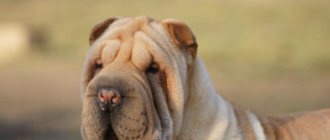Dog hunting, which was previously only the domain of the upper classes, has become much more accessible these days. And the choice of hunting dogs (from wolfhounds to greyhounds) will pleasantly please you not only with their excellent exterior (the appearance of the dogs), but also with decent working qualities. Of all the variety of breeds, it is worth noting such as the Russian Piebald Hound (also known as the Anglo-Russian Hound).
Brief history of the breed
Hunting with hounds was originally the domain of aristocrats, and the work of hounds was considered auxiliary and only the quality of the pack’s work was assessed. It was at this time (or more precisely, in 1810) that the first mentions of Russian piebald hounds appeared. The breed was developed completely by accident, by infusing Russian hounds with the blood of foxhounds, which were extremely popular at that time. It is thanks to Foxhounds that this breed is also called Anglo-Russian. It was only by 1925 that the Russian piebald was officially recognized and began to be bred.
Historical reference
The dog began to gain popularity after an exhibition in 1874
The breed has existed, according to some sources, since the 13th century. There is an opinion that the dogs were brought in during the Tatar-Mongol invasion. According to other sources, the Russian hound is the result of crossing European pointers and native Russian dogs.
But documentary evidence dates back to the 19th century. During this period, selection work began to improve the breed.
An image of the breed is on a fresco in the St. Sophia Cathedral in Kyiv.
In Russia, the breed is included in a single standard, but the International Canine Organization does not recognize it.
How can an Anglo-Russian hound help a hunter?
Rather, the question should be posed this way: is it necessary to use dogs for hunting? After all, keeping them is troublesome: you have to feed them, walk them, teach them, and in the 21st century, you can easily use some kind of gadget instead of dogs. For example, a night vision device or a thermal imager.
Dog lovers will answer unequivocally: it is necessary! And there are several reasons for this:
- The dogs will find the game. Of course, relying on hunting experience and technological progress, you can search for game on your own, especially large ones, but when it comes to birds or hares, even modern technologies can’t always help. But the dogs will find the game, and (in the case of hounds) drive the hunter out.
- The dogs give time to prepare for the shot. If the hare actually breaks away from under your feet, then you are unlikely to have time to aim or shoot. The hound will help “lift” him and bring him straight to you. All that remains is to prepare properly and wait.
- The dogs will bring game. Especially useful when hunting in deep snow or other conditions that make movement difficult. In addition, the chance of loss will be significantly reduced.
- A faithful dog is man's best friend. And no gadget can replace this.
- Hunting with a hound will bring much more drive and pleasure from the process than a simple trip with a gun.
However, hunting with a dog also has its disadvantages:
- An inexperienced hunter, who does not know the animal and its habits well, would rather spoil the dog than train it.
- Some animals are better hunted without using hounds.
- Training requires patience and a certain amount of tolerance.
- Some dogs may have birth defects that make training or rutting difficult.
How did the process work?
The parfors hunt was led by its leader, who, as a rule, was the owner of a pack of hounds, a picker, who was assisted by two or three hounds. At the beginning of the hunt, hounds were allowed into the bushes located near the gathering place or in the forest. Due to the fact that the game was prepared in advance, the dogs quickly picked up the scent. While the beast was circling without leaving the forest, the hunters were driving around the edge.
As soon as the dogs drove the game out of the forest, a mad race began after it and the dogs, not recognizing any obstacles. Stone walls that enclosed fields, fences, and wide ditches were also overcome. When the dogs lost the track, the race was interrupted for a while, and then began again when the track was found. After a fox or a hare was driven away, the dogs instantly tore them into small pieces. If it was possible to recapture the game from the dogs, they were given the head, entrails, and pazankas (parts of the legs between the paw and the knee).
What is the best Russian piebald hound to hunt?
The hound is considered a universal dog, capable of hunting any forest inhabitants, but hounds perform best in hunting hare, fox, wolf, raccoon dog and wild boar.
However, remember that if the hounds are accustomed to hunting wild boar (which usually takes place in open areas), then they will get used to a simple and completely unpretentious rut. If they have to hunt more cautious and cunning animals (for example, foxes or hares), then serious difficulties will arise.
From the Gauls to the present day
As Roman authors testify, already the first French kings (around the 3rd century AD) had very large packs of hound dogs. They hunted such large and strong animals as bears, wild boars, moose, aurochs, and bison. They were driven to the point of exhaustion, which in French sounds like par force, that is, “by force.” After the animals fell, they were finished off with arrows, spears or darts.
The implementation of such a grandiose action entailed the need to maintain a large number of hound dogs, vicious and strong. When the hunt for foxes, wolves and hares took place, hunters on horseback were also needed. At first, the game was driven out of the forest by hounds to the edge of the field, where horse-drawn hunters waited for it along with the hounds in packs.
According to medieval chronicles, in France alone in the 14th century there were more than 20 thousand hunters with hounds. Gradually, French breeds of hound dogs began to “emerge” (under Louis IX), among which there are four main ones. This:
- royal whites,
- St. Hubert's - black,
- Saint Louis - gray,
- Breton redheads.
Description of the main characteristics of the hound:
- viscosity (perseverance in pursuit);
- fidelity (barks only at the hunted game);
- crawling (ability to find game);
- Paratus (fast rut);
- restlessness (tirelessness during prolonged pursuit);
- good voice (strong, clear, musical and ringing bark);
- skill (work skill);
- good instinct;
- gregariousness (the ability to drive an animal in a pack or in a band, without separating from each other);
- quarrelsomeness (quick gathering of a bow or flock);
- evenness of legs (cohesion of the flock);
- urge (obedience to a challenge);
- politeness (obedience to the hunter, as well as indifference to livestock).
Russian piebald hounds: features and character
- Calm and balanced character.
- The Russian Piebald Hound can withstand enormous physical exertion, but do not overuse it, otherwise the dog may lose interest in the rut or simply become spoiled.
- Excellent sense of smell. It is difficult even for experienced foxes to throw off the scent of a well-trained hound.
- She has a strong voice, so when hunting she will easily give a signal to her owner.
- Doesn't bark or show aggression without a reason.
- The breed is short-haired, which means there will be fewer problems with cleaning the premises during shedding.
Advantages and disadvantages
The dog is calm and non-aggressive towards people
The breed has a large number of advantages:
- good hunting qualities;
- speed, agility and strength;
- fast learner;
- loud voice (which is a disadvantage when living in an apartment);
- ability to work independently or in a flock;
- soft undercoat, it allows the dog to stay in the enclosure in winter;
- devotion to the owner and his family;
- getting along with other dogs.
Flaws:
- freedom-loving, touchy, know their worth;
- cunning, can manipulate;
- not suitable for living in an apartment;
- often get lost while hunting, carried away by the pursuit of game.
Russian pinto hound puppies
If you are planning to get a puppy, then when choosing one you should pay attention to:
- Papers. Study the pedigree, it is recommended - up to 4 generations. “C” students can give weak offspring, given the increased number of frauds at exhibitions, give preference to “excellent” students. Be sure to find out whether the puppies had cattlemen in their family (those who attacked domestic animals) and silent ones (they drove the animal silently, without barking). If there is at least one such ancestor, you should not take a puppy.
- Mother. Must be thin, but not emaciated, contented, and not exhibit any behavioral abnormalities.
- Appearance of a puppy. Well-fed, cheerful, active, agile and, naturally, clean.
- Room. Dry and quite spacious.
Nutrition
Russian hounds are unpretentious in their diet. Depending on the owner's preferences, dry or natural food can be used.
Dry has several advantages:
- easy to calculate the daily requirement;
- no need to waste time planning menus and preparing food.
But it is important to pay attention to the components and their quality. It is recommended to choose premium food intended for active dogs (Trainer, Monge, Djosera).
Feed includes all essential vitamins
Natural feeding should be clearly planned so that all vitamins and nutrients are balanced. Menu recommendations:
- Meat products are required. These include lean lamb, veal, rabbit, turkey and chicken. It is allowed to use offal (liver, kidneys, lungs, stomach). Pork is prohibited.
- Sea fish without bones (can be raw) and boiled river fish.
- Egg (1 piece per week).
- Porridges cooked with broth or milk.
- Vegetables and fruits (boiled or stewed cabbage, zucchini, turnips).
- Milk and fermented milk products (cottage cheese with whey, hard cheese, low-fat kefir 2 times a week).
Prohibited products:
- heat-treated bones;
- bread;
- confectionery;
- spicy, salty;
- spices;
- fried foods.
An adult dog is fed 2 times a day. There should always be clean, fresh water in the drinking bowl, especially in hot weather.
A dog living on the street should receive more food.
Care
The Russian piebald is extremely unpretentious; it can be brushed quite rarely (once every few days), and bathed as needed. Given their calm nature, such dogs get along well with children, but they are very active, and they require either frequent active walks (when the owner plays with the dog or lets it off a leash) or a large living space (the yard of a private house or cottage).
You should not show weakness or indulge the dog’s whims, otherwise the piebald hound will later become completely disobedient.
Also, you should not deceive her by calling her to you or in any other cases. If the dog distrusts you, then it will take a long time to learn and be reluctant to follow commands.
The last rule is not to “humanize” the dog. Do not let her sleep on the bed, eat from the table, do not try to comfort an upset animal of any breed with affection, etc.
Training
Russian Pinto Hound puppies train best when they are three months old. From this time until 3.5 months or a year, depending on the approach to training (Training is the development of the hound’s innate skills and consolidation of the developed ones), it is necessary to teach the puppy the commands “Come to me!” "Stand!" and others included in the OKD (general training course), as well as accustom to the sound of a horn and a shot.
To train a hound to listen to a horn, you need to blow it before feeding, and blow it on the same horn, the sound of which the piebald hound will remember forever, and when hunting, it will never confuse the sound of the horns. You should not blow the horn all day long, otherwise the dog will lose all interest in it and become uncontrollable in the forest. This, in turn, can not only ruin the pleasure of hunting, but also lead to the death or loss of the dog.
The next step is to teach the dog the command “Open!” (to make the dog throw the food). After training, you will be able to safely take prey while hunting. Before feeding, the animal is tied to a long leash (from 5 to 8 meters), threaded through a ring fixed in the wall, and the end of the leash remains in the hands of the owner. Throw some treat and give the command “Discover!” If the hound bares its teeth and growls, then pull the dog to the ring with one hand, and take the bone with the other. Russian pinto hound puppies usually understand the command 2-3 times, however, if the puppy persists, as an exception, you can lightly punish him. After completing the command correctly, praise the dog and give it a treat (but not the one you took away, of course).
From a very early age, it is necessary for your Russian Piebald to become accustomed to being polite (a term described in “Basic Characteristics”) and not attacking livestock and/or your other pets. If a dog manages to kill any domestic animal at least once and is not punished, then this vice will remain with it for the rest of its life.
Therefore (especially if the dog is vicious, or you live in the city), try to bring the dog near livestock and birds and patiently teach it complete indifference by pulling back or punishing it.
Mating
It is recommended to start mating at the age of two, when the dog is able to bear healthy offspring, although puberty begins at 8-10 months.
The owners agree on a specific date, focusing on the bitch’s cycle. On the 13-15th day of estrus, she exhibits the following symptoms - the loop becomes loose and soft, light discharge appears, she becomes more playful or aggressive. On the appointed day, the female is taken to the male. During the first mating, the animals need help - support the bitch under the belly, and guide the male into the loop. You can invite a specially trained person. Repeated mating is carried out after 2 days.
Often the price for mating is set by the owner of the dog (usually 1 puppy or a certain percentage after the sale). If the female does not become pregnant, then nothing is paid.
Caring for puppies
Already at 1 month, babies should be able to eat finely chopped meat, cottage cheese and dry food
If a female gives birth to many puppies, they can be divided in half and fed in turn. Smaller animals are best placed on the lower nipples, they are the best.
From 3 weeks, puppies can be fed (if there is not enough milk, then from 2 weeks). For this, it is recommended to use Royal Canin dry food. This is a porridge intended for puppies, which needs to be filled with boiled water. It is well absorbed and does not cause stomach upset.
They are introduced to solid food gradually, adding other foods every 2-3 days. If the puppy digests them well, then they give him something new.
Feeding mode:
- up to 1.5 months - 6 times a day;
- from 1.5 to 3 months - 4 times a day;
- from 3 to 6 months - 3 times a day;
- after 6 months - 2 times a day.
Almost immediately after birth, it is recommended to give puppies vitamin complexes. They contain calcium gluconate, brewer's yeast, phytin, bone meal, etc.
Washing a puppy under 3 months is prohibited.
Catch-up
A puppy of any breed can be introduced to the forest at the age of 4 months, but walks should last about an hour and not turn into a challenge, otherwise there is a high risk of overworking the puppy and causing him to become disgusted with the process.
By 8-9 months, subject to the above-mentioned requirements, training can begin. Many authoritative experts recommend starting training at one year old, arguing that any breed of hound reaches the necessary physical development at this time. Naturally, you can start training earlier, but if you value your pet, it is better to wait a while rather than spoil the animal.
For the first training, it is recommended to take the dog alone, without an experienced “partner”. Despite the fact that this way the dog will learn faster and better, it can become exhausted trying to keep the rhythm of an experienced dog, and also adopt his possible vices.
The duration of the process depends on weather conditions and the physical condition of the dog. This usually takes about 3-4 hours with a break of 20-30 minutes after an hour or two of training.
It is best to carry out the race in the fall, in September or October, or in the spring, in April or May, in specially designated places. The Anglo-Russian hound, which was hunted in winter (along a white trail), is considered to be less well trained, since it is widely believed that in this case it looks for the trail “by eye” and will not cope with the spring-autumn hunt. The hunt is usually carried out on hares, and then - depending on who you plan to hunt and how.
How does the process work? The hunter walks through the area, and so that the speed of the dog’s movement matches his own, poking (by shouting, urging the dog to action) from time to time. The squealing should be approximately the same, since the dog remembers the characteristic squealing of the owner in the same way as the sound of the horn. The dogs, not hearing the owner, begin to search for him and either get lost or search with a minimum crawling depth (game search zone).
If the Russian piebald goes too far, then, on the contrary, it is necessary to scurry less often.
If a dog is afraid of the forest and stays near its feet, then under no circumstances should you scold it for this, much less punish it. Otherwise, the fear of the forest will take root firmly in her mind, and she will have to forget about a good hunting dog.
But, sooner or later (this is the nature of the breed) you will find a hare and raise it.
“Hunting and game management” No. 9 1959
RUSSIAN PIETA HOUND
In RUSSIA in the 19th and first half of the 20th centuries, one of the most prominent places among hound breeds belonged to the Anglo-Russian, which is currently called the Russian pinto hound.
One of the reasons that led to its formation was the fact that, under the influence of unsystematic management of the breed in the middle of the last century, Russian hounds ceased to represent a single type, a single breed, but rather turned into many independent subtypes and families, often having the blood of Polish hounds, harlequin and busty.
Therefore, some Russian dog hunting lovers were unwittingly seduced by the Foxhound, a dog of high breed at that time, well-built, beautiful and elegantly colored. In addition, the Foxhound breed was very uniform and standard, it had parasites and anger towards the beast. The Russian hounds especially lacked the latter in some hunts, where the dogs even became unsuitable for wolf hunting.
The most famous were the Anglo-Russian packs of Bereznikov, Gatchina, Pershino (which had a significant admixture of French hounds and was distinguished by its peculiar piebald color) and, finally, the most famous Glebov pack, which was formalized as Anglo-Russian around 1830 after Glebov widely used the Burgum and Cromwell foxhounds in breeding. In addition to these packs, we must also mention a small but quickly emerging group of Kramarenko’s dogs.
Glebovsky hounds were especially famous, as they were distinguished by outstanding field qualities, especially scent, paratism and malice towards the wolf. These dogs played a major role in the formation of the modern Russian pinto hound.
During the Civil War, the bulk of the Anglo-Russian hounds died, and at the first Moscow Dog Show in 1923, in Soviet times, there were only eight of them, and of extremely different types.
Since there was no breed standard yet, at one exhibition black-and-piebald Anglo-Russian dogs and nightingale-piebald Anglo-Franco-Russian dogs competed in a common ring, and at the other they were divided into two breeds. Subsequently, valuable, high-quality and breed-typical sires began to appear, and the initial formation of its exterior began to undergo significant movement.
In the December issue of the All-Khotsoyuz magazine “Okhotnik” for 1924, an appeal from Dr. Kornilovich from the city of Novo-Khopersk appeared, proposing to use Vopil, Plakun, Sorochay and Soroka, which belonged to him, in the breed. These dogs were close descendants of Glebov’s dogs; they were very purebred, but somewhat small and poor-boned. Kornilovitch's hounds played a big role in the creation of the modern Russian pinto hound. They were included in the pedigrees of the dogs of the Central VVOO (for example, the Sorochaya line), and from them also came the pack of Tikhomirov and Listak from the city of Ostrov, Pskov region. The descendants of this pack, Sorochai and Soroka Muscovite Yakunin, in turn gave rise to the DSO Dynamo group of dogs, which served as a model for describing the breed characteristics of the modern type of Russian pinto hound.
In 1925, the First All-Union Cynological Congress recognized the Anglo-Russian hounds as a full-fledged breed and developed the first standard - a description of breed characteristics.
At the Moscow Dog Show in 1927, Zalivay Chukaeva from Zaraysk, Ryazan was shown
areas. This survivor was of rare breed and had an excellent build. Numerous offspring were obtained from him, which were included in many of the best modern lines of the breed. Zalivai Chukaeva received a field diploma and became the first champion in the breed. He, like Kornilovitch’s dogs, came from the dogs of the Glebov pack.
In addition to him, Grom Glavatchuk (Tula), also descended from the Glebov hounds, had a significant influence on the breed.
An important role in the formation of the breed was also played by the champion Pomchilo Bocharova, the Foxhound Cheshire-Stella of Zubarovsky, exported from England, Bandit Maslovsky (from the mating of Bandit with Cheshire-Stella, Swat and Vyplach were obtained, which served to create some lines of Anglo-Russian hounds). It is impossible not to mention Dushila Kuptsov, the best representative of the Anglo-Franco-Russian hounds. This survivor is also found in many pedigrees of the current Russian piebald hounds. By the end of the thirties and the beginning of the forties, several of the most interesting groups - factory lines - gained fame.
1) Ostrovskaya – Tikhomirov – Listaka, created through close inbreeding based on Kornilovitch’s dogs. Among these hounds, many had a good exterior, some were large in stature, for example, Skvorets - Tikhomirova, others were rather small, for example. Call - Loseva. There were two leading colors - black and piebald with blush and crimson piebald. The flock scored well in trials, but had a short range and mediocre voices.
2) The Tula pack of hunters, formed in the twenties of the current century and used mainly for collective hunts for wolves. At first, the pack was motley and diverse, and there were many small dogs in it. The origins of these hounds were the dogs of the Glebov and Pershinskaya piebald packs; There were also dogs of unknown origin. In recent years, the Tula flock has received the blood of the best sires of the DSO Dynamo kennel, has become more homogeneous and is reaching a high conformation level.
3) The Kiev factory line of hounds of the kennel TS VVOO was formed on the basis of an interline crossing of the line of the champion Zalivaya VRKS 8040 of the kennel Ukrzagotpushnina (b. Chukaeva) and the line of dogs Kornilovych and Plakun the first - Zyanevich. The pedigree line created in this way was dominated by sires of Glebov origin, and also through Dushila - Kuptsov the blood of the Pershin Anglo-Franco-Russian flock entered. Dogs of the Kyiv line were black and piebald with blush and occasionally gray-piebald with blush.
4) Moscow group with a large number of descendants of the champion Pomchila - Bocharov, champion Zalivaya 8040 and the beginnings of the future Dynamo line. Both named survivors were extraordinary field workers, knitting and skilled.
5) Marinsk plant group - in Sukhinichi, Kaluga region. Its founders were Flute - Marina (granddaughter of Foxhound Cheshire-Stella) and Hurricane Smirnova - Gryaznova from the city of Ruza. The dogs of this group were very large and bony, but damp and lethargic, and had a gray-piebald color with blush.
In the period of the 20s - 30s there was a bright line of Anglo-Russian hounds Lyudskov - Kazansky, descended from the Pershin and Glebov dogs and distinguished by exceptional working qualities (especially viscosity and skill). Through Clarinet 2/G she participated in the final formation of the current Dynamo type, which later became the model of the breed.
The difficult conditions of 1941–1945, of course, had a negative impact on the quantitative growth of the breed, but its qualitative condition, on the contrary, improved. In 1943, at the Moscow exhibition, three flocks of the Anglo-Russian breed were shown: 1) Moscow City Council DSO Dynamo, 2) TS VVOO, mainly of Kyiv origin, and 3) Tula,
Exceptional breeding, uniformity and excellent conformation put the Dynamo pack in first place.
The 1950 - 1954 standard was copied from the exterior of this Dynamo pinto hound. Despite the fact that the Dynamo hounds did not work well in the field at that time, the producers of this line immediately took a leading place in the breed, which ensured a general rise in its exterior.
Subsequently, after the infusion of the blood of Clarinet VRKOS 2/G, through his son Ryday, a number of field winners appeared in the Dynamo nursery: Danube II, Danube III, Zanoza, Minorka, Plakun, Sorochay, Soroka and others. This finally approved this breeding line of Russian piebald hounds.
Thus, the Anglo-Russian hound, which existed in old Russia for about 130 years and yet did not develop into a real Russian breed during this period, in new conditions, only in 25 years, from a crossbreed became a clearly defined beautiful breed, which is rightfully named Russian pinto hound.
Nowadays the breed has reached a high level in terms of exterior quality and uniformity. Exterior variations fit quite clearly into the concept of one breed, and the only slight deviations that exist are essentially obligatory for each factory breed. The unity of appearance is emphasized by the fact that the black and piebald color in blush has become almost the only one. Other colors are found as an exception. For example, out of 91 Russian piebald hounds that were at the XXV Moscow Anniversary Exhibition in 1957, there was not a single scarlet piebald or dog of a distinct gray piebald color.
Along with successes in the formation of the breed, some difficulties arose in its further development and improvement. Excessive enthusiasm for the exterior of the main Dynamo factory line, the leaders of which are Balamut II, Dogonyay, Danube I; The violin was not working, leading to a weakening of the field qualities in the breed, but this danger was eliminated by the creation of a new line of Clarinet - Rydaya. The leader of this new, working line, Ryday, played a decisive positive role, but on his mother’s side he came from dogs of the so-called “parallel” pack of the VVOO of the Kiev Military District, among whose immediate ancestors there were dogs of dubious quality and origin (Mukhtarka, Plakun II - Zinevich). This pack was dominated by raw dogs with elongated and atypical heads. The careless use of Ryday in the Ukrainian SSR, where he ended up, his numerous matings with the descendants of a “parallel” pack, which were inbreeding on the indicated unwanted ancestors, led to the consolidation of exterior defects and a decrease in the field qualities of some groups of Russian piebald hounds in Ukraine. However, there are also very valuable lines there, which also speaks to the prospects for the general improvement of the breed.
Currently, Russian piebald hounds are widespread in the Ukrainian SSR and in a number of regions of the RSFSR: in Tula, Kaluga, Bryansk, Leningrad; Voronezh, Kalinin and, especially, in Moscow.
Among the piebald Russian hounds in Moscow, the main ones are the following lines and groups:
Factory line DSO Dynamo. The former two lines of Balamut II and Rydaya have now merged into one, refreshed by mating Dynamo sires with the son of Baron, taken from Germany, Okh Gugel. Modern Dynamo hounds have not retained the brilliant exterior and uniformity that distinguished them in the early 40s. At the same time, working qualities regressed.
Groups of piebald hounds from military groups of branches of the All-Army Military Hunting Society. The main breeding core of these groups was the former pack of the military hunting society of the Kyiv Military District. Here, the Foxhound Baron is also introduced.
Piebald hounds of the Moscow Hunter Society. This group is very diverse in appearance, but among it there are many good field workers. This was the result of breed management, built on the use of the best working sires in matings and on consolidating their qualities through rather careful inbreeding.
In the late forties and especially in the fifties, it became almost impossible to find a good Russian piebald hound whose pedigree did not include the Dynamo kennel dogs Balamut II, Dogonya I, Danube I, Danube II, Skripka and others. This led to an intensified search for sires of other bloodlines and to the use of a survivor of the Baron Foxhound type exported from Germany, which was not a working dog and therefore was not desirable for the breed. In the first generations, nothing outstanding was obtained from Baron, and in a number of cases the established type of the breed was sharply disrupted.
The direction in breeding work with the Russian pinto hound should be different. Biological science has proven that it is enough to take sires from different geographical areas to paralyze the harmful effects of inbreeding in the breed.
For Moscow and other regions of the RSFSR, it will be necessary to import direct descendants of the hounds of Kornilovich and the former kennel of Ukrzagotpushnina that have survived in Ukraine (Poltava and Sumy).
Among the Poltava and Sumy families of Russian piebald hounds there are very purebred dogs, interesting in appearance and valuable in working qualities. We need to breed our best female sires with Sumy sires, for example, Kornet Lantukha and Karai Boronosa from the Trostyanets district. You should also bring puppies from the Sumy region from outstanding breeders, for example, Flute - Karachintseva, Kara - Butsyk, Gaida - Pankov from the Krasnopolsky region.
In parallel with this, and in order to create new lines of the breed in the regions of the Ukrainian SSR, it is necessary to arrange matings of the most valuable local females with the best Moscow, Leningrad, Tula breeders and at the same time purchase for Ukraine puppies from first-class breeders of the RSFSR, for example, Chaika I - Zaretskova (Moscow) , Fimki - P. Chekulaev (Leningrad) and others.
The current description of the characteristics of the Russian Pinto Hound breed defines its exterior as follows. The dog must have a height at the withers of 57 - 65 cm for the mature dogs, and 3 cm lower for the older dogs. The height of the dog at the sacrum is 1-2 cm lower than at the withers, or equal to it.
The ratio of length to height is close to square (102-105). The weight of survivors is 27-33 kg, of survivors - 25-29 kg.
The main color is black and piebald with blush, purple piebald and gray piebald with blush are also acceptable. The hair on the head, ears and legs is short, and on other parts of the body it is longer - up to 4-5 cm. The undercoat should be sufficiently developed. The head should be dry with an oblong, rather voluminous skull. The brow ridges and the transition from the skull to the muzzle should not be sharp. The occipital protuberance is poorly developed. The profile of the muzzle is close to a rectangle. Lips are dry. The nose is black. The ears are hanging, thin, short, triangular, slightly rounded; fit snugly to the head and set high. The eyes are dark brown with an oblique slit. The neck is rounded, dry, approximately equal in length to the head. The body is somewhat barrel-shaped. The back has a slight upward arch. Belly - selected. The forelimbs are dry and bony. The angle of the glenohumeral joint is close to 100°. The hind limbs are dry, bony with well-defined joints, the angle of which is 135°-140°. The paws are large, balled, oval. The rut (tail) is saber-shaped, thick at the base, thinning towards the end, no longer than up to the hock joint. Carried by the dog with a steep rise.
Currently, we can talk about three main types in the breed. The first of them includes hounds with a particularly dry build and relatively high legs. This type can be called somewhat lightweight. Its characteristic representatives should be considered such dogs as Chaika I and Chaika II - Zaretskova (Moscow), Fishka II - Chekulaeva (Leningrad). Many of these dogs are related in origin to the Rydaev line of Dynamo hounds.
Another, more unique type was obtained as a result of the introduction of the Baron Foxhound into the breed. The most noticeable features here are the elongation of the neck and body, the dampness of the head and the very straight, strong front legs with short-toed, collected paws.
The third type is close to the main Dynamo one, with some improvement. With the same power and not too light heads, this type of modern Russian pinto hound looks drier and more collected. A good example of Russian piebald hounds of this kind can be the dogs of the current Tula social pack, such as Dogonyay, Plakun, Danube, Dobychka.
In terms of its composure, proportionality of build, dryness and strong constitution, as well as its working qualities proven by field tests, the third type must be considered the most desirable.
The latest data indicate an ongoing improvement in the working qualities of the Russian pinto hound. At the 25th anniversary Moscow exhibition, the senior age group included 69 percent of dogs certified in field trials, which has never happened before. For example, the results of the work of the Moscow Hound Test Station in the spring of 1958 speak convincingly in defense of the Russian piebald breed, where the percentage of certified Russian piebald hounds turned out to be one and a half times higher than Russian ones. It should be noted that the voice of the Russian pinto breed today is undoubtedly better than that of the Russian breed. As an example, we can cite at least the average scores received for voice by hounds who competed in 1957 at competitions in two cities - Moscow and Leningrad. The average score for the strength of voices of the Russian hounds was 6, and that of the piebalds was 8. The average score for musicality and figuration was 1.4 for the Russian hounds, and 2.5 for the Russian piebalds.
Meanwhile, disputes often arise among hunters. Some claim that the Russian hound breed is superior to the Russian piebald hound breed, while others prove the opposite.
It is high time to understand and admit that both of our breeds of hounds are good and have the same right to exist. The choice of one breed or another by hunters depends only on what color the hunter prefers in hounds - piebald or solid, as well as what exterior he likes.
V. KAZANSKY, Expert and judge of the All-Russian category
Skol
Soon the prey will be out of sight. In this case, the hounds continue to search for her, but following the scent. Usually a young piebald hound loses track after the first hare discount and becomes silent (the so-called hiatus). It is at this time that the hunter must intervene.
IMPORTANT! The hare's mark is a little behind where the hound lost the trail.
The hunter must either find and scare away the hare, or help the dog do this. It is necessary for her to understand that she needs to continue searching for the trail. It happens that dogs cannot take it again. Then the hunter must walk a circle with the dog, and then another larger one, in order to detect the trail. The more persistent you are in searching for a trace during the first surges, the more persistently the dog will search for traces subsequently. And vice versa, the dogs of lazy hunters, who switch after a discount to another trail of a hare, will behave in exactly the same way during the hunt, so such owners may not even count on prey and a good rut.
And a couple more tips:
- Don't leave your hound alone in the woods, hoping it will return home on its own. This instills in dogs a passion for wandering and negatively affects their character.
- During the race, do not be distracted by anything. Do not shoot squirrels or birds, do not collect mushrooms, etc. The Russian Piebald will pick up your habit and will subsequently be often distracted during its work.
Autumn hunt
At the beginning of the hunting season, the hare is not yet scared, so it is easier to catch it. The optimal month for hunting is November, when the weather is humid, the trees have lost their leaves, the plants have withered and fallen to the ground. In such conditions, the work of a hare hound is characterized by stability and high viscosity.
In the fall, hares most often arrange roosts near winter crop fields, sometimes even in the fields themselves, if the height of the vegetation allows.
The oblique moves away from pursuit in circles, often zig-zagging and returning to its resting place. Therefore, it is best for the hunter to:
- wait for the hare not far from the roosting area;
- do not lash out at the dog’s voice, unmasking yourself, scaring away the hare;
- carefully monitor the hare’s runs, determining the trajectory of its loops;
- When in ambush, behave extremely quietly.
You should shoot in the side of the animal so as not to injure the dog following it.
Find out what shot to use when hunting hare.
Brief summary
- The Russian piebald hound is ideally suited for hunting hares and foxes.
- The calm and balanced nature of the breed will make training easier.
- Hunters without experience are not recommended to train hounds.
- It is necessary to approach the choice of puppies with due responsibility, checking not only the papers, but also the puppies themselves, as well as the conditions of their detention.
- The first training of this breed is carried out either in spring or autumn.
- For training, you should not pair up an experienced dog.
- Don't skip the silence and help the dog get back on the trail.
Rhodesian Ridgeback (African Lion Hound)
The Rhodesian Ridgeback (African Lion Hound) originated in Rhodesia and is the only dog recognized by all classifications as a hound. It can even hunt large animals and predators, easily tolerates different climates, and feels good on plains and fields. To search, it uses smell and instinct and continuously follows the trail; it can resist prey. This species is characterized by loyalty, independence, and obedience. Best kept outside the city.
Views: 948
is a breed that was bred many centuries ago, but there is not much information about it preserved in the archives.
Some information has survived to this day from the 19th century, but all documentary data is very vague, and the illustrations often look quite fantastic. For example, on one of the frescoes of the St. Sophia Cathedral in Kyiv, built in the 11th century, three dogs are depicted: one rushes at a wild boar, the second, similar to modern huskies, looks at a squirrel in a tree. The third dog is chasing a deer and clearly illustrates the fact that even then hunting with Russian hounds existed; it is the dog that is outwardly similar to the modern breed of hounds.
And also to the fox and other forest animals, most likely, it began to spread widely after the Tatar yoke. Then many Slavs borrowed from the Tatars the tradition of hunting with dogs. Judging by historical documents, they also tried to hunt wild boar with a hound, and quite successfully. But more often the object of the hunt was a fur-bearing animal and especially a fox, which was most often hunted with such dogs.
The first documentary mentions of this breed are found in the publication of V. Levshin in 1815. In his “Book for Hunters” he wrote that three types of hound dogs were known in Russia:
- The first ones had thick hair and thick drooping tails, folded ears, medium size, and they were called Kostroma hounds.
- Others were called Courland hounds, which were distinguished by thicker hair, a hairier muzzle, and shorter stature.
- The third breed, described in Levshin’s book, was called loshaya, since it was with it that they hunted elk and deer. These hounds were long-haired, larger than the previous two, had pointed ears and a large head. Losy dogs were also called Streltsy hunting dogs.
Later, in 1843, in a journal, he described that hound dogs, also known as “Kostroma hunting dogs,” originated from dogs imported from England that belonged to landowners who loved to hunt foxes.
Then in 1845, in one of the magazines of that time, a version of Khomyakov appeared, who insisted that the breed of Russian hounds had existed for about 40 years, and it was bred by the Tatar people. According to this article, it is believed that the ancestor of these dogs was the gray and tan Siberian hound.
